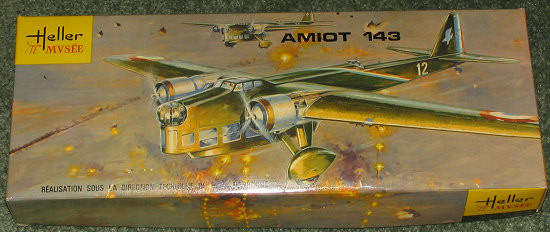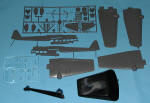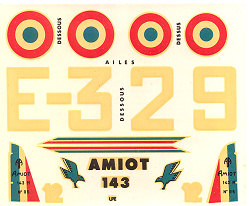
| KIT: | Heller 1/72 Amiot 143M |
| KIT #: | 390 |
| PRICE: | $4.00 from a desperate vendor at the nats |
| DECALS: | One option |
| REVIEWER: | Scott Van Aken |
| NOTES: | Original boxing |

| HISTORY |
Development
Felix Amiotís 1925 design was selected in 1928 for production over rivals Bleriot 137, Breguet 410 and SPCA 30. The prototype designated Amiot 140 flew in 1931, but actual production of the aging design did not begin until 1935 and continued for lack of a replacement until March 1937.
Despite being of an ungainly two-tiered structure, slow and unmaneuverable, and of obsolescent architecture, the Amiot 143M was a sturdy plane which was popular with its pilots. Notable were the very thick wings whose engines were accessible in flight.
The Amiot 143M production model mounted a turret in the nose and dorsal turrets, both of which housed one or two 7.5 mm MAC 1934 MGs. In addition, a single 7.5mm MAC 1934 MGs was mounted in both fore and aft of the ventral bombing gondola.
The Amiot 143M entered service in July, 1935. The design was already ten years old and was quite out of date. Nevertheless, 87 Amiot 143M were in the front line. 50 equipped four metropolitan groupes: GBs I/34 and II/34 in the north, GBs I/38 and II/38 in the East, and 17 equipped one African groupe as of May 10, 1940.
During the Phoney War, Amiot 143M groupes carried out reconnaissance and leaflet raids over Germany. Upon the start of the Battle of France, the Amiot 143M was used in night attacks on German lines of communications. The most significant action involving the Amiot 143M was a daring daylight raid on German bridgeheads near Sedan took place on May 14, 1940. A force of thirteen planes from GBs I/34, II/34, and II/38 led by Commandant de Laubier encountered German Messerschmitt Bf 109 fighters en route. Twelve bombers were destroyed.
By the time of the Armistice, the Amiot 143M had dropped a total of 523 tons of bombs. 53 Amiot 143Ms were in the Unoccupied Zone and 25 were in French North Africa. They were reorganized into GBs I/38 and II/38 and were used until July 1941 when they were replaced by LeO 451 bombers.
Some planes of the II/38 served as a transports for the French in Syria. This groupe later went over to the Allied side after their landings in Africa. The last Amiot 143M was retired from service in February 1944.
A few Amiot 143M are reported to have been commandeered by the Germans and used as transports. Only 11 planes were left in the Unoccupied Zone when it was occupied by the Germans in 1943, and only three were flight worthy.
Had the war gone on a little longer for France, it is likely that all of the Amiot 143M would have ended up in a training role, having been replaced by more modern bombers such as the Breguet 693. The obsolete plane was never intended to have such an important role come war time, but slow French production made its use necessary--often being pulled from training squadrons to shore up bomber groupes!
| THE KIT |
 This
is another of Heller's early kits. I say this as it comes with something one
doesn't see in modern kits - a display stand. It is also missing something that
we have all come to expect in kits - an interior. It is also lacking anything
that looks like engines, providing only blanking plates. In Heller's defense,
there are large covers over the front of the engines, so you really won't
missing not having engines. There are the usual sunken areas and some ejector
pin marks to deal with, but no real flash.
This
is another of Heller's early kits. I say this as it comes with something one
doesn't see in modern kits - a display stand. It is also missing something that
we have all come to expect in kits - an interior. It is also lacking anything
that looks like engines, providing only blanking plates. In Heller's defense,
there are large covers over the front of the engines, so you really won't
missing not having engines. There are the usual sunken areas and some ejector
pin marks to deal with, but no real flash.
Molded in grey plastic, all the detail is raised and
there are some very nicely done rivet detail, something not out of place for
aircraft of this era. With fabric control surfaces, you'd expect to see some
sort of fabric-like detail, but what you get is baby-butt smooth plastic.
Despite having no interior, you are provided with a lot of clear plastic to put
into the variou s window openings.
The cockpit transparency is a two-piece affair that will have a seam running
down the center of it. Something not easy to remove or fill. Turrets are
provided for the nose and the upper dorsal position. Large, slab wings with
sturdy looking gear round out the various parts in the kit. This also includes a
ball so you can display your bomber on a rather hefty stand.
s window openings.
The cockpit transparency is a two-piece affair that will have a seam running
down the center of it. Something not easy to remove or fill. Turrets are
provided for the nose and the upper dorsal position. Large, slab wings with
sturdy looking gear round out the various parts in the kit. This also includes a
ball so you can display your bomber on a rather hefty stand.
This must be the export version of the kit as the lone sheet of instructions are completely in English. There is a well written series of construction steps that accompany the two exploded views of all the various parts. Markings are for the box art aircraft from 3/2 EB 22 painted in overall chocolate brown. The decals have succumbed to the ravages of time and are most unusable. Finding replacements will be difficult, but perhaps Heller will be able to supply replacements when the company gets reorganized after its recent bout of receivership.
| CONCLUSIONS |
Though not the first aircraft that comes to mind when one thinks of French Bombers, it does fit the mold and is suitably homely for the period. Its lack of any interior is probably its biggest fault, but most who build this kit will either do so for nostalgia purposes or will really want to fix it up by scratchbuilding.
| REFERENCES |
Wikipedia and the internet
December 2006
Once again, thanks to your editor who grabbed this one during the Saturday
sell-off at the Nationals. If you would like your product reviewed fairly and quickly by a
site that has over 325,000 visitors a month, please
contact
me or see other details in the
Note to
Contributors.